
The pearl-bordered fritillary is a butterfly of the family Nymphalidae found in Europe and through Russia across the Palearctic to the north of Kazakhstan.

Rhaphigaster nebulosa, common name mottled shieldbug, is a species of stink bug in the family Pentatomidae.
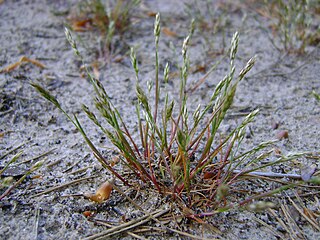
Aira praecox is a species of grass known by several common names, including early hair-grass, yellow hairgrass and spike hairgrass. It is native to Europe, where it is found in dry, sandy places, on rocky outcrops, and in heath grassland. It also grows in North America as an introduced species, where it can be found on the east and west coasts in sandy or rocky areas, such as beaches and roadsides. This is a tuft-forming annual grass growing up to about 10 to 15 centimeters in maximum height. The thin, narrow leaves are located at the base of the stem, and are typically 0.3–2 millimeters wide. It bears small, tightly congested inflorescences of purple-tinted green bisexual spikelets.

Agriphila tristella, the common grass-veneer, is a species of moth of the family Crambidae found in Europe and Asia.

Chilo phragmitella is a species of moth of the family Crambidae, sometimes referred to by the vernacular names wainscot veneer or reed veneer. It was first described by Jacob Hübner between 1805 and 1810 as Tinea phragmitella, and is the type species of the genus Chilo.
The Yantai stingray, Hemitrygon laevigata, is a little-known species of stingray in the family Dasyatidae, inhabiting shallow waters in the northwestern Pacific Ocean off the coasts of China and Japan. Measuring no more than 20–30 cm (7.9–11.8 in) across, this species is characterized by its diamond-shaped pectoral fin disc wider than long, completely smooth skin, dorsal coloration of dark irregular spots on a yellowish gray-brown background, and ventral coloration of more spots on a white background with yellowish margins. One of the three most common stingrays sold for food in China, the slow-reproducing Yantai stingray faces possible overfishing and habitat degradation, and its numbers appear to be declining. The International Union for Conservation of Nature (IUCN) has assessed it as vulnerable.
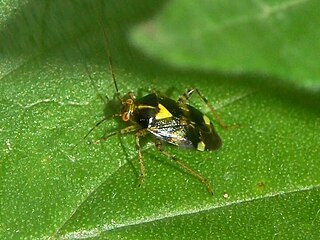
Liocoris tripustulatus or the common nettle bug is a species of plant bug belonging to the family Miridae, subfamily Mirinae. The species was first described by Johan Christian Fabricius in 1781.

Eudonia pallida is a species of moth of the family Crambidae. It was described by John Curtis in 1827 and is known from most of Europe. Its alternative name is the Marsh Grey.

Hydrometra stagnorum, the common water-measurer, is a species of aquatic bugs in the family Hydrometridae, the water measurers.
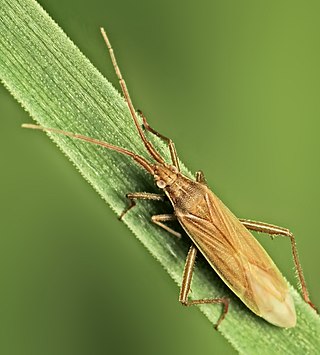
Stenodema calcarata is a species of bug from Miridae family, that can be found in Europe and across the Palearctic to Central Asia, the Russian Far East, Siberia, northern China, Korea and Japan.
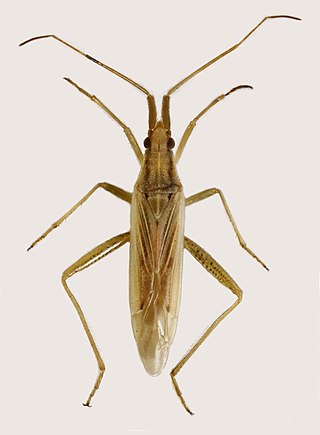
Stenodema laevigatum, or sometimes Stenodema laevigata, is a species of bug from Miridae family. The species have a gray to brown elongated body, with the eyes located backwards in the head. Sometimes they might come in green colour. They are 8–10 millimetres (0.31–0.39 in) in length, which makes it a rather big species of its kind. They are common in the United Kingdom, and throughout the rest of Europe. then east across the Palearctic through Asia Minor and the Caucasus to northern China.
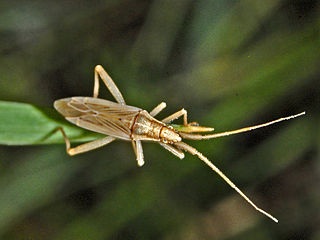
Stenodema is a genus of Palaearctic, Oriental and Nearctic plant bugs in the family Miridae and the tribe Stenodemini.

Bactra furfurana, the mottled marble, is a moth of the family Tortricidae described by Adrian Hardy Haworth in 1811. It is found in the Nearctic and Palearctic realms.

Deleaster dichrous is a species of rove beetle (Staphylinidae) that is native to Europe, specifically the United Kingdom. It has also been introduced to North America.
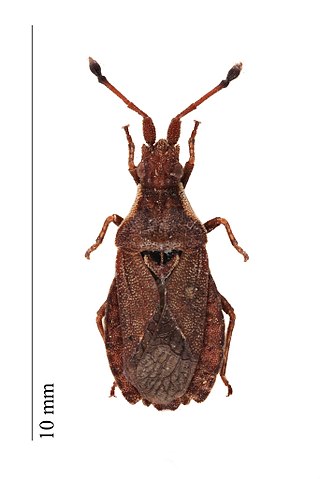
Spathocera dalmanii, known as Dalman's leatherbug, is a species of insect in the family Coreidae, tribe Coreini. It is native to Europe.
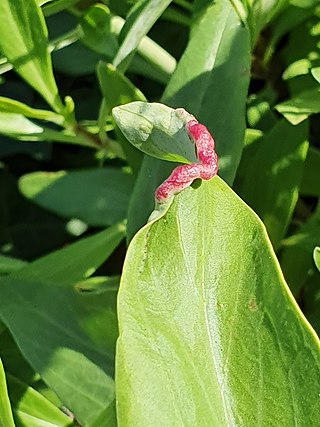
Trioza centranthi is a sap-sucking hemipteran bug in the family Triozidae which creates galls on the leaves and flowers of Centranthus and Valerianella species. It was first described by Jean Nicolas Vallot, a French entomologist in 1829 and is found in Europe.
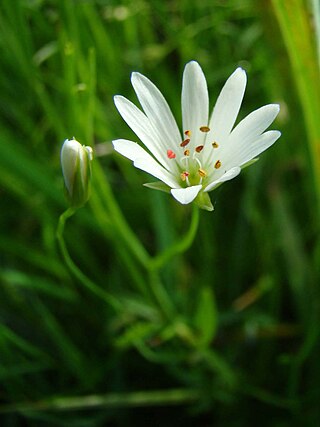
Stellaria palustris, commonly known as marsh stitchwort, is a species of flowering plant belonging to the family Caryophyllaceae. It was first described in 1791.
Diacria trispinosa is a holoplanktonic species of gastropods belonging to the family Cavoliniidae. It is classified as a mesoplankton. It is a pteropod.
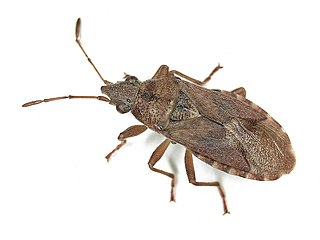
Orsillus depressus is a species of seed bug in the family Lygaeidae. It is a terrestrial insect native to southern Europe. It is considered a naturalized introduced species in the UK. O. depressus was first recorded in England in the 1980s and is now common throughout central and southern England. In southern Europe, its host plants are trees in Cupressaceae while in the UK Lawson's cypress is the most common host plant. O. depressus is approximately 6 mm in length and has a browny-orange coloration. Like many other species in Lygaeidae, O. depressus is a phytophagous species, feeding on plants, and it is commonly found in woodland/forest habitats and in cultivated areas of gardens and parks.
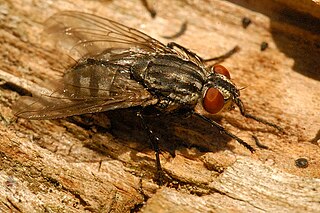
Brachicoma devia is a species of flesh fly belonging to genus of Brachicoma. This species sometimes associated with various bumblebees, as its larvae is parasitic on the developing bumblebee larvae.


















